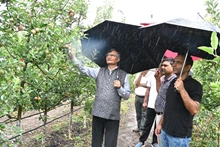
Since the Green Revolution of the 1950s, agricultural innovations like synthetic fertilizers, chemical pesticides, and high-yield cereal crops have created an abundance of low-cost food. This abundance has been pivotal in feeding a rapidly growing global population and fostering economic prosperity in many regions. However, this focus on quantity over quality has given rise to significant health and environmental concerns. The current food system is failing farmers, consumers, and the environment in various ways, necessitating urgent reforms to improve its performance and resilience.
What are Food Systems?
Food systems encompass everything from "farm to fork" – the entire process of producing, transporting, processing, and consuming food. This includes the origin of seeds, planting methods, growth materials, harvesting, processing, packaging, distribution, and the final consumption of food products. For example, understanding the journey of flour involves tracing its path from seed sourcing and planting to processing, packaging, and final use, whether fed to livestock or consumed by humans. Each stage involves intricate networks and numerous stakeholders, highlighting the complexity and interdependence of global food systems.
Factors Behind Failing Food Systems
A combination of factors contributes to the shortcomings of food systems, with dire consequences for millions worldwide. As of now, approximately 783 million people are chronically hungry. Conflict disrupts agricultural activities and markets, driving up food prices and limiting access to food. Unsustainable natural resource management reduces the capacity to produce food and amplifies the impact of climate shocks. About 40 percent of the world’s land is degraded, severely affecting food production.
Additionally, major disruptions in global markets have exposed vulnerabilities and inequalities. Low-income countries, which allocate over a third of their merchandise export revenue to food imports, are particularly susceptible to shocks like the COVID-19 pandemic and the war in Ukraine. These disruptions have disproportionately impacted their food security, reversing development gains.
Ways Current Food Systems Are Failing Humanity
1. Environmental and Health Costs
The global food system's emphasis on industrial agriculture comes with hidden environmental costs. Conventional agriculture, responsible for significant greenhouse gas emissions, pollution, and wildlife destruction, costs the environment about $3 trillion annually. These externalized costs, including purifying contaminated water and treating diseases related to poor nutrition, are often borne by communities and taxpayers.
2. Public Health Risks
The industrial food system also poses public health risks. Intensive livestock farming, characterized by genetic similarities within flocks and herds, increases susceptibility to pathogens and facilitates the spread of viruses from animals to humans. This intensive farming model, coupled with the destruction of natural buffers through deforestation and urban expansion, contributes to the emergence of zoonotic diseases.
Moreover, the widespread use of antimicrobials in livestock to promote growth has led to antimicrobial resistance. This resistance renders antimicrobials less effective in treating infections, posing a significant threat to public health. Currently, about 700,000 people die annually from resistant infections, and this number could surpass deaths from cancer by 2050.
3. Nutritional Deficiencies & Chronic Diseases
The food system's reliance on commodity crops has led to dietary imbalances, with 60 percent of dietary energy coming from just three cereals: rice, maize, and wheat. This calorie-based approach, while reducing hunger, fails to meet nutritional recommendations, contributing to rising obesity rates and related chronic diseases such as heart disease, stroke, diabetes, and certain cancers.
4. Land Use Inefficiencies and Inequality
Livestock farming, despite insufficient global supplies of pulses, fruits, and vegetables, dominates agricultural land use. Between 1970 and 2011, livestock numbers increased significantly, with about 60 percent of agricultural land used for grazing. This focus on livestock perpetuates a cycle of supply and demand, leading to widespread malnutrition.
The global food system also establishes inequality. Small farms, which constitute 72 percent of all farms, occupy only 8 percent of agricultural land, while large farms control 65 percent. This disproportionate control limits the development of technologies beneficial to resource-poor small-hold farmers, particularly in developing countries. Additionally, food affordable to the poor is often nutrient-poor, leading to micronutrient deficiencies that impair cognitive development, increase disease susceptibility, and reduce economic productivity.
Current food systems poses significant environmental and health risks, exacerbates inequalities, and struggles to provide nutritious food to all. Addressing these challenges requires comprehensive reforms to create a more equitable, sustainable, and resilient food system that can meet the needs of a growing global population while safeguarding the environment and public health.












